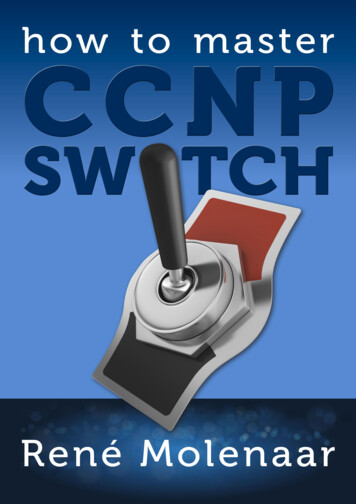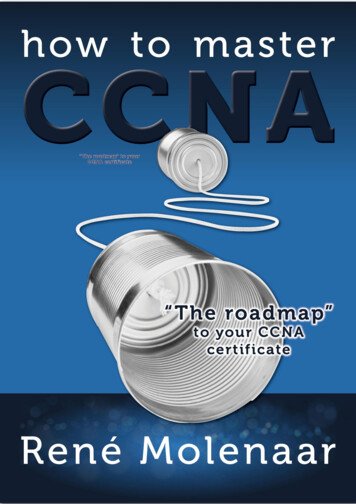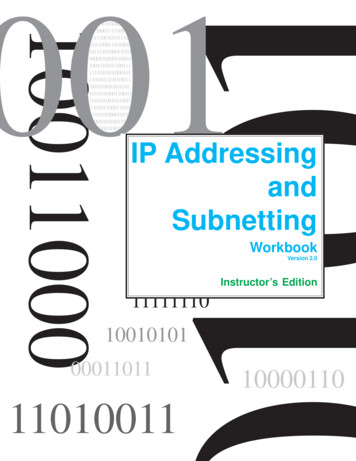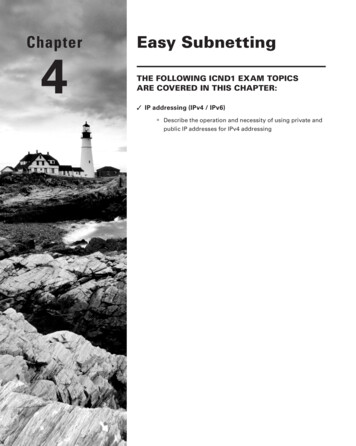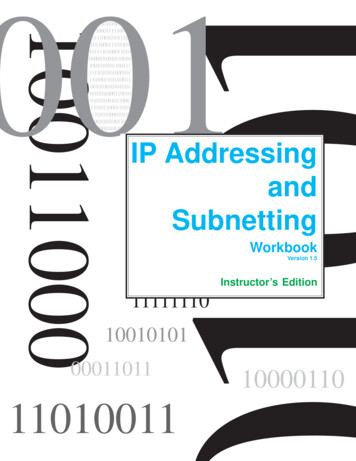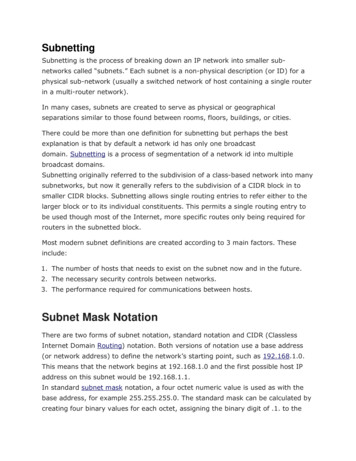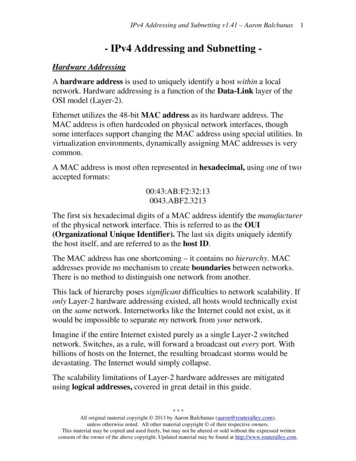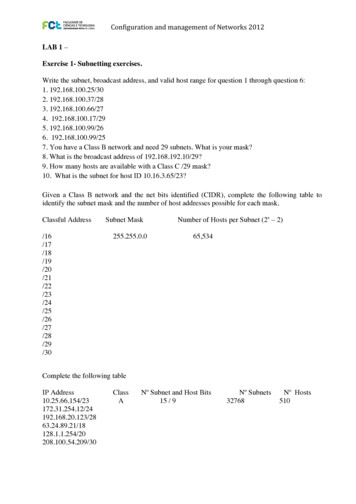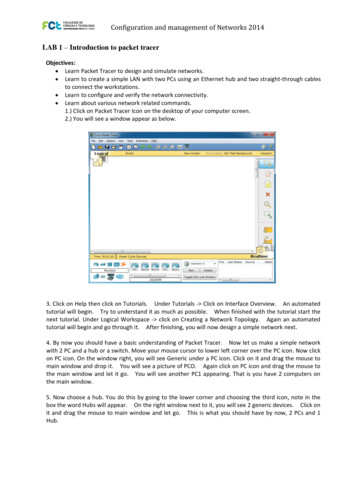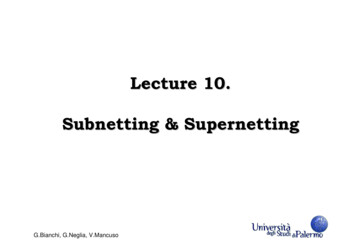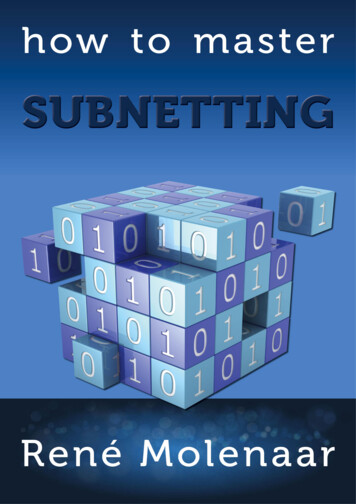
Transcription
How to Master SubnettingAll contents copyright C 2002-2013 by René Molenaar. All rights reserved. No part of thisdocument or the related files may be reproduced or transmitted in any form, by anymeans (electronic, photocopying, recording, or otherwise) without the prior writtenpermission of the publisher.Limit of Liability and Disclaimer of Warranty: The publisher has used its best efforts inpreparing this book, and the information provided herein is provided "as is." RenéMolenaar. makes no representation or warranties with respect to the accuracy orcompleteness of the contents of this book and specifically disclaims any impliedwarranties of merchantability or fitness for any particular purpose and shall in no eventbe liable for any loss of profit or any other commercial damage, including but not limitedto special, incidental, consequential, or other damages.Trademarks: This book identifies product names and services known to be trademarks,registered trademarks, or service marks of their respective holders. They are usedthroughout this book in an editorial fashion only. In addition, terms suspected of beingtrademarks, registered trademarks, or service marks have been appropriatelycapitalized, although René Molenaar cannot attest to the accuracy of this information.Use of a term in this book should not be regarded as affecting the validity of anytrademark, registered trademark, or service mark. René Molenaar is not associated withany product or vendor mentioned in this book.www.gns3vault.comPage 2 of 103
How to Master SubnettingIntroductionBinary and hexadecimal numbers are a complete mystery for many of us. Often we don‟tfind it really interesting because on the internet there are plenty of “subnet” or “binary”calculators where you can easily calculate from decimal to binary to hexadecimal or theother way around, without knowing how the exact calculation works.This is no problem when you are not configuring or designing networks on a daily basis,but it will be a problem as soon as you take a networking exam, so it‟s best to know howto do these calculations off the top of your head.Another advantage you will have is once you have mastered the art of binarycalculations you can immediately “see” how big a network is and what the subnet maskis when people start throwing numbers at you.One of the things I do in life is work as a Cisco Certified System Instructor (CCSI) and Inoticed many people have trouble finding out what the subnet mask is, how many hostsare in a subnet, how to do summarization and so they fail at passing exams like CCNA orCCNP. Anyone working with networks on a professional level should be able to do binarycalculations if you ask me.This book will teach you how to calculate subnets and subnet masks, how to calculatethe numbers of hosts available etc. for class A,B and C networks. And the best part: Youwill be able to do this off the top of your head, no need to write stuff down!Once you have mastered the tricks in this book you will wonder why you ever haddifficulty solving subnetting questions :)Enjoy reading my book and good luck mastering your binary and subnetting skills!P.S. There are 10 types of people in the world: Those that understand binary, and thosewho don't!P.P.S. If you have any questions or comments about this book, please let me ult.comPage 3 of 103
How to Master SubnettingIndexIntroduction . 31. Binary Basics . 52. Welcome to Subnetting . 73. Subnetting: The beginning. 134. Subnetting: The Fast Way . 315. Classless Inter-Domain Routing . 436. Variable length subnet mask (VLSM) . 457. Summarization . 538. Hexadecimal calculations . 579. Tackling miscellaneous subnetting questions . 5910. Create your own cheat sheet . 6311. Final Thoughts . 64Appendix A – Answers to exercises . 65www.gns3vault.comPage 4 of 103
How to Master Subnetting1. Binary BasicsBefore we start calculating subnets and talk about IP addressing, let‟s first check outsome basics of binary calculations. We are all used to work with decimal numbers wherewe count from 1 till 10. This is easy because we have 10 fingers so we don‟t have tocount off the top of our head.In the binary system, we only work with 0 or 1.0 Off1 OnBits1286432168421The bit on the far left side is called the most significant bit (MSB) because this bit hasthe highest value. The bit on the far right side is called the least significant bit (LSB)because this one has the lowest value.So how do we convert decimal numbers into binary? Let me show you an example:If we want the decimal number “0” in binary this means we leave all the bits “off”.Bits0128064032016080402010Let‟s take the number 178 and turn it into binary, just start at the left and see which bits“fit in” to make this number. 128 32 16 2 178.Bits178128164032116180402110Just one more! Let‟s turn 255 into binary. 128 64 32 16 8 4 2 1 255Bits255128643216842111111111As you can see 255 is the highest decimal number you can create when you have 8 bitsto play with.As you can see, whenever you add a bit, the decimal value doubles.For example: 2,4,8,16,32,64,128,256,512,1024,2048 and so on. This is calledthe “powers of 2”.This is a good moment to create your own “cheat sheet” . Take a piece of paperand write down the 8 bits for yourself.www.gns3vault.comPage 5 of 103
How to Master SubnettingExercise 1:See if you can solve the following decimal to binary calculations:Bits1254187192441471286432168421Now try to do it the other way around and calculate from binary to 00400100121001011011111The appendix of this book will show you the answers.www.gns3vault.comPage 6 of 103
How to Master Subnetting2. Welcome to SubnettingBefore we start calculating subnets, the first thing we need to do is take a look at whatsubnets and IP addresses are.An IP address is a numeric value that you configure on every device in a network, thinkabout computers, laptops, servers but also networking equipment like routers, firewallsand switches. The IP address identifies every device with a “unique” number. Deviceswithin the same IP subnet are able to communicate without using a router.Let‟s take a look at some of the terminology you might encounter when we talk about IPaddresses:IP Terminology:Bit(s)ByteOctetNibbleNetwork addressSubnetBroadcastaddressA bit has 2 possible values, 1 or 0. (on or off)A byte is 8 bits.An octet is just like a byte 8 bits, you often see byte or octet bothbeing used.A nibble is 4 bits, we‟ll talk about this more in the Hexadecimalchapter.When we talk about routing, the network address is important.Routers use the network address to send IP packets to the rightdestination. 192.168.1.0 with subnet mask 255.255.255.0 is anexample of a network address.A subnet is a network that you split up in multiple smallersubnetworks.The broadcast address is being used by applications andcomputers to send information to all devices within a subnet,192.168.1.255 with subnet mask 255.255.255.0 is an example ofa broadcast address.Hierarchical IP addressing:IP addresses are 32 bits, divided in 4 “blocks” also known as 4 bytes or octets. Everybyte has 8 bits. 4x8 32 bits.There are many ways to write down an IP 0000.10101000.0000001.0000001C0.A8.01.01Decimal is what we are used to work with, as this is the way you normally configure anIP address in operating systems like Microsoft Windows, Linux or most networkingequipment. Hexadecimal you won‟t see often but for example you might encounter thisin the windows registry.www.gns3vault.comPage 7 of 103
How to Master SubnettingIP addresses are hierarchical unlike non-hierarchical addresses like MAC-addresses. Thishas some advantages, you can use a lot of IP addresses (with 32 bits the biggestnumber you can create is 4,3 billion or to be precise 4,294,967,296). The advantage ofhaving a hierarchical model is needed for routing, imagine that every router on theplanet would need to know every IP address on the planet. Routing wouldn‟t be veryefficient that way A better solution is a hierarchical model where we use “network”, “subnet” and “hosts”.Try to compare this to phone numbers:00310131234567This is the country code for The NetherlandsThis is the city code for TilburgThis is a single number for a customer.The complete phone number is 0031-013-1234567.IP addresses use a similar hierarchical structure.Network addresses:Every subnet has 1 network address!The network address is a unique identification of the network. Every device within thesame subnet shares this network address in its IP address, for .168.100. is the network address and .1, .2 and .3 are host addresses. The IPaddress will tell you in what subnet they are located. The network address has to be thesame for all the hosts; the host part has to be unique. When the Internet was inventedthey created different “classes” of networks each with a different size. At this momentthere are 3 classes that are important to us:Class A:Class B:Class C:Class D:Class E:www.gns3vault.com8 bits8 bits8 bits8 orkNetworkHostHostNetworkHostHostHostPage 8 of 103
How to Master SubnettingBroadcast addresses:Every subnet has 1 broadcast address!When we talk about broadcasts in IP world, we talk about layer3 broadcasts. In case youhave no idea what I‟m talking about take a look at the OSI model:OSI kData LinkPhysicalThe OSI model describes a layered approach of a network, getting into the details of allthe different layers of the OSI model is outside the scope of the book, but to get anunderstanding of broadcasts it‟s important to look at layer 2 and layer 3.There‟s a layer2 and layer3 broadcast, and there‟s a big difference between them. Whenwe look at a LAN (Local Area Network) we are probably using Ethernet. MAC addressesare used to uniquely identify a network device, for example: 00:50:56:c0:00:08 is aMAC address that uniquely identifies my computer. On a LAN it‟s possible to send a layer2 broadcast so that all computers on the LAN segment will receive this message(Ethernet Frame). The destination MAC address would be FF:FF:FF:FF:FF:FF (when youread the hexadecimal chapter you‟ll see that FF:FF:FF:FF:FF:FF is a string with only 1‟sin binary).Now let‟s take a look at a layer 3 broadcast. Layer 3 is where we talk about IPaddressing, and we can also send a broadcast. For example take the 192.168.1.0network.192.168.1.255 for this subnet is the broadcast address, this means when we send an IPpacket to 192.168.1.255 that all hosts on this subnet will receive this packet. Pretty neatright? Some old applications might still use this form of communication.www.gns3vault.comPage 9 of 103
How to Master SubnettingClass A:Back to our network addresses, let‟s take a look at Class A. The first bit always has to bea 0. This leaves us 7 bits to “play” with. The lowest value you can create by changing allbits to “0” is 0. By changing all 7 bits to “1” you get 127.Bits01271280064013201160180140120110164 32 16 8 4 2 1 127.As you can see the Class A range is between 0. and 127.Class B:For a class B network the first bit has to be a 1. The second bit has to be a 0.Bits12819112811640032011601801401201101128 32 16 8 4 2 1 191As you can see class B networks always start with 128. and the last network is 191.Class C:For a class C network the first bit has to be a 1, the second bit a 1 and the third a 0.Bits19222312811641132001601801401201101128 64 192128 64 16 8 4 2 1 223As you can see Class B networks start at 192. and the last network is 223.Class D and E:There is also a class D for multicast traffic which starts at 224. and ends at 239. Class Eis for “research usage”. We are not going to use these classes for our binary calculations.www.gns3vault.comPage 10 of 103
How to Master SubnettingClass A Addressing:A class A network has 1 byte reserved for the network address which means the other 3bytes are left for hosts. This means we have a couple of networks and every network canhave a lot of hosts (how to determine how many hosts each network has we will f we look at the IP address 53.21.43.63 then “53” is the network address and“21.43.63” is the host address, all machines on this subnet will have the “53” as 43.ByteHosts63Class B Addressing:A class B network has 2 bytes reserved for the network address which means the other 2bytes are left for hosts. This means we have even more networks but less hosts pernetwork compared to class A.ByteNetworkByteNetworkByte
Bit(s) A bit has 2 possible values, 1 or 0. (on or off) Byte A byte is 8 bits. Octet An octet is just like a byte 8 bits, you often see byte or octet both being used. Nibble A nibble is 4 bits, we‟ll talk about this more in the Hexadecimal chapter. Network address When we talk about routing, the network address is important. Routers use the network address to send IP packets to the right

